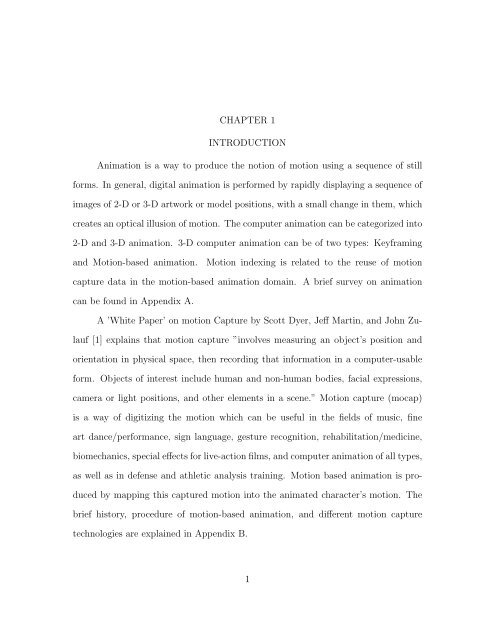A COMPARISON AND EVALUATION OF MOTION INDEXING ...
A COMPARISON AND EVALUATION OF MOTION INDEXING ...
A COMPARISON AND EVALUATION OF MOTION INDEXING ...
Create successful ePaper yourself
Turn your PDF publications into a flip-book with our unique Google optimized e-Paper software.
CHAPTER 1<br />
INTRODUCTION<br />
Animation is a way to produce the notion of motion using a sequence of still<br />
forms. In general, digital animation is performed by rapidly displaying a sequence of<br />
images of 2-D or 3-D artwork or model positions, with a small change in them, which<br />
creates an optical illusion of motion. The computer animation can be categorized into<br />
2-D and 3-D animation. 3-D computer animation can be of two types: Keyframing<br />
and Motion-based animation. Motion indexing is related to the reuse of motion<br />
capture data in the motion-based animation domain. A brief survey on animation<br />
can be found in Appendix A.<br />
A ’White Paper’ on motion Capture by Scott Dyer, Jeff Martin, and John Zu-<br />
lauf [1] explains that motion capture ”involves measuring an object’s position and<br />
orientation in physical space, then recording that information in a computer-usable<br />
form. Objects of interest include human and non-human bodies, facial expressions,<br />
camera or light positions, and other elements in a scene.” Motion capture (mocap)<br />
is a way of digitizing the motion which can be useful in the fields of music, fine<br />
art dance/performance, sign language, gesture recognition, rehabilitation/medicine,<br />
biomechanics, special effects for live-action films, and computer animation of all types,<br />
as well as in defense and athletic analysis training. Motion based animation is pro-<br />
duced by mapping this captured motion into the animated character’s motion. The<br />
brief history, procedure of motion-based animation, and different motion capture<br />
technologies are explained in Appendix B.<br />
1
















